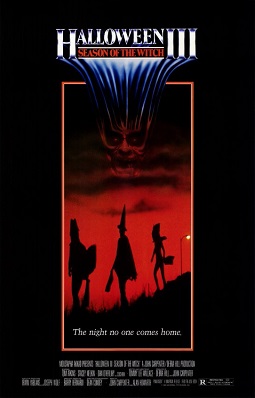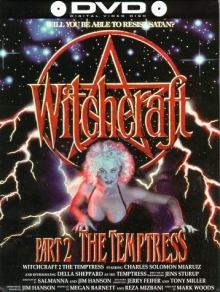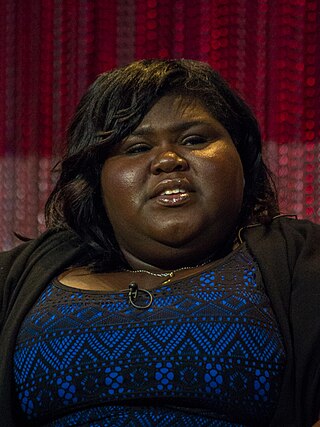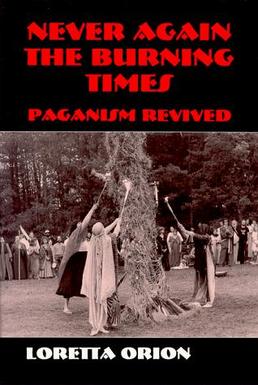
A Book of Shadows is a book containing religious text and instructions for magical rituals found within the Neopagan religion of Wicca. Since its conception, it has made its way into many pagan practices and paths. The most famous Book of Shadows was created by the pioneering Wiccan Gerald Gardner sometime in the late 1940s or early 1950s, and which he utilised first in his Bricket Wood coven and then in other covens which he founded in following decades. The Book of Shadows is also used by other Wiccan traditions, such as Alexandrian Wicca and Mohsianism, and with the rise of books teaching people how to begin following non-initiatory Wicca in the 1970s onward, the idea of the Book of Shadows was then further propagated amongst solitary practitioners unconnected to earlier, initiatory traditions.

Halloween III: Season of the Witch is a 1982 American science fiction horror film and the third installment in the Halloween film series. It is the first film to be written and directed by Tommy Lee Wallace. John Carpenter and Debra Hill, the creators of Halloween and Halloween II, return as producers. Halloween III is the only entry in the series that does not feature the series antagonist, Michael Myers. After the film's disappointing reception and box office performance, Michael Myers was brought back six years later in Halloween 4: The Return of Michael Myers (1988).

Frances Hardman Conroy is an American actress. She is best known for playing Ruth Fisher on the television series Six Feet Under (2001–2005), for which she won a Golden Globe and three Screen Actors Guild Awards, and received four Primetime Emmy Awards nominations for Outstanding Lead Actress in a Drama Series. She is also known for playing the older version of Moira O'Hara in season one of the television anthology series American Horror Story, which garnered Conroy her first Saturn Award for Best Supporting Actress on Television nomination, and as well a Primetime Emmy Awards nomination for Outstanding Supporting Actress in a Miniseries or a Movie. Conroy subsequently portrayed The Angel of Death, Myrtle Snow, Gloria Mott, Mama Polk, Bebe Babbitt, and Belle Noir on seven further seasons of the show: Asylum, Coven, Freak Show, Roanoke, Cult, Apocalypse, and Double Feature, respectively. Conroy is the fourth actor who has appeared in most seasons of the show. For her performances in Coven & Double Feature, she was nominated again for a Primetime Emmy Award for Outstanding Supporting Actress in a Miniseries or a Movie.

The City of the Dead is a 1960 supernatural horror film directed by John Llewellyn Moxey and starring Christopher Lee, Venetia Stevenson, Betta St. John, Patricia Jessel and Valentine Dyall. The film marks the directorial debut of Moxey. It was produced in the United Kingdom but set in America, and the British actors were required to speak with North American accents throughout.
Maxine Sanders is a key figure in the development of modern pagan witchcraft and Wicca and, along with her late husband, Alex Sanders, the co-founder of Alexandrian Wicca.

The Witches of Eastwick is a 1987 American supernatural comedy film directed by George Miller and starring Jack Nicholson as Daryl Van Horne, alongside Cher, Michelle Pfeiffer and Susan Sarandon as the titular witches. The film is based on John Updike's 1984 novel of the same name.

Witchcraft II: The Temptress is a 1990 American horror film directed by Mark Woods and starring Charles Solomon, Delia Sheppard, David Homb, Mia M. Ruiz, Jay Richardson, Cheryl Janecky, Mary Shelley, and Frank Woods. The screenplay was written by Jim Hanson and Sal Manna. The film is a sequel to the 1988 direct-to-video film Witchcraft, and the second film in the Witchcraft series. It is followed by Witchcraft III: The Kiss of Death.

The Witches is a 1966 British horror film directed by Cyril Frankel and starring Joan Fontaine, Alec McCowen, Kay Walsh, Ann Bell, Ingrid Boulting and Gwen Ffrangcon-Davies. Made by Hammer Films, it was adapted by Nigel Kneale from the 1960 novel The Devil's Own by Norah Lofts.
The history of Wicca documents the rise of the Neopagan religion of Wicca and related witchcraft-based Neopagan religions. Wicca originated in the early 20th century, when it developed amongst secretive covens in England who were basing their religious beliefs and practices upon what they read of the historical witch-cult in the works of such writers as Margaret Murray. It also is based on the beliefs from the magic that Gerald Gardner saw when he was in India. It was subsequently founded in the 1950s by Gardner, who claimed to have been initiated into the Craft – as Wicca is often known – by the New Forest coven in 1939. Gardner's form of Wicca, the Gardnerian tradition, was spread by both him and his followers like the High Priestesses Doreen Valiente, Patricia Crowther and Eleanor Bone into other parts of the British Isles, and also into other, predominantly English-speaking, countries across the world. In the 1960s, new figures arose in Britain who popularized their own forms of the religion, including Robert Cochrane, Sybil Leek and Alex Sanders, and organizations began to be formed to propagate it, such as the Witchcraft Research Association. It was during this decade that the faith was transported to the United States, where it was further adapted into new traditions such as Feri, 1734 and Dianic Wicca in the ensuing decades, and where organizations such as the Covenant of the Goddess were formed.

Cultural depictions of the Salem witch trials abound in art, literature and popular media in the United States, from the early 19th century to the present day. The literary and dramatic depictions are discussed in Marion Gibson's Witchcraft Myths in American Culture and see also Bernard Rosenthal's Salem Story: Reading the Witch Trials of 1692

The witch-cult hypothesis is a discredited theory that the witch trials of the Early Modern period were an attempt to suppress a pagan religion that had survived the Christianization of Europe. According to its proponents, accused witches were actually followers of this alleged religion. They argue that the supposed 'witch cult' revolved around worshiping a Horned God of fertility and the underworld, whose Christian persecutors identified with the Devil, and whose followers held nocturnal rites at the witches' Sabbath.

Gabourey “Gabby” Sidibe is an American actress. She made her acting debut in the 2009 film Precious, a role that earned her the Independent Spirit Award for Best Female Lead, in addition to nominations for the Golden Globe and Academy Award for Best Actress. Her other film roles include Tower Heist (2011), White Bird in a Blizzard (2014), Grimsby (2016), and Antebellum (2020).

A Community of Witches: Contemporary Neo-Paganism and Witchcraft in the United States is a sociological study of the Wiccan and wider Pagan community in the Northeastern United States. It was written by American sociologist Helen A. Berger of the West Chester University of Pennsylvania and first published in 1999 by the University of South Carolina Press. It was released as a part of a series of academic books entitled Studies in Comparative Religion, edited by Frederick M. Denny, a religious studies scholar at the University of Chicago.

Never Again the Burning Times: Paganism Revisited is an anthropological study of the Wiccan and wider Pagan community in the United States. It was written by the American anthropologist Loretta Orion and published by Waveland Press in 1995.

Living Witchcraft: A Contemporary American Coven is a sociological study of an American coven of Wiccans who operated in Atlanta, Georgia during the early 1990s. It was co-written by the sociologist Allen Scarboro, psychologist Nancy Campbell and literary critic Shirley Stave and first published by Praeger in 1994. Although largely sociological, the study was interdisciplinary, and included both insider and outsider perspectives into the coven; Stave was an initiate and a practicing Wiccan while Scarboro and Campbell remained non-initiates throughout the course of their research.

The third season of the American horror anthology television series American Horror Story, subtitled Coven, is set in 2013 New Orleans and follows a coven of witches descended from Salem as they fight for survival and features flashbacks to the Salem witch trials in 1692, as well as the 1830s, 1910s, 1960s, 1970s, and 1990s. The ensemble cast includes Sarah Paulson, Taissa Farmiga, Frances Conroy, Emma Roberts, Lily Rabe, Evan Peters, Denis O'Hare, Kathy Bates and Jessica Lange, with all returning from previous seasons, except Roberts and Bates. The season marks the first to not feature cast mainstays Dylan McDermott and Zachary Quinto.

"Bitchcraft" is the premiere episode of the third season of the anthology television series American Horror Story, which premiered on October 9, 2013, on the cable network FX. The episode title is a portmanteau of the words bitch and witchcraft.
"The Sacred Taking" is the eighth episode of the third season of the anthology television series American Horror Story, which premiered on December 4, 2013, on the cable network FX. The episode was written by Ryan Murphy and directed by Alfonso Gomez-Rejon.
"The Magical Delights of Stevie Nicks" is the tenth episode of the third season of the anthology television series American Horror Story, which premiered on January 8, 2014, on the cable network FX. The episode was written by James Wong and directed by Alfonso Gomez-Rejon. In this episode, Fiona tries to out the next Supreme with a visit by Stevie Nicks and Madison tries to eliminate her competition for the Supremacy. This episode marks Nicks' acting debut. She agreed to do the show based on her love of Glee, another show from the same creative team. Angela Bassett, Danny Huston and Patti LuPone guest star as Marie Laveau, the Axeman, and Joan Ramsey, respectively. This episode is rated TV-MA (LV).
Witchcraft is a horror film series, that as of March 2018, has 16 direct to video installments, making it one of the horror genre's longest-running interconnected series. It began in 1988, and most films focus, at least partially, on the character of William Spanner, who is a powerful warlock who fights for good despite having an evil lineage.















